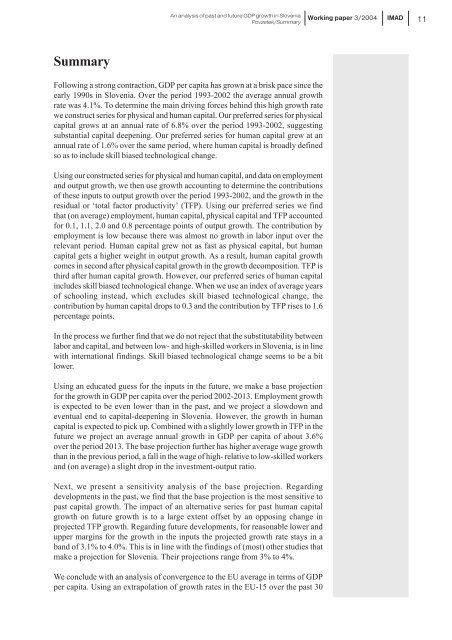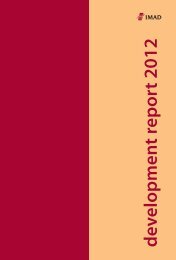Working papers published by IMAD ISSN: 1318-1920 ... - UMAR
Working papers published by IMAD ISSN: 1318-1920 ... - UMAR
Working papers published by IMAD ISSN: 1318-1920 ... - UMAR
You also want an ePaper? Increase the reach of your titles
YUMPU automatically turns print PDFs into web optimized ePapers that Google loves.
An analysis of past and future GDP growth in Slovenia<br />
Povzetek/Summary<br />
<strong>Working</strong> paper 3/2004<br />
<strong>IMAD</strong><br />
11<br />
Summary<br />
Following a strong contraction, GDP per capita has grown at a brisk pace since the<br />
early 1990s in Slovenia. Over the period 1993-2002 the average annual growth<br />
rate was 4.1%. To determine the main driving forces behind this high growth rate<br />
we construct series for physical and human capital. Our preferred series for physical<br />
capital grows at an annual rate of 6.8% over the period 1993-2002, suggesting<br />
substantial capital deepening. Our preferred series for human capital grew at an<br />
annual rate of 1.6% over the same period, where human capital is broadly defined<br />
so as to include skill biased technological change.<br />
Using our constructed series for physical and human capital, and data on employment<br />
and output growth, we then use growth accounting to determine the contributions<br />
of these inputs to output growth over the period 1993-2002, and the growth in the<br />
residual or ‘total factor productivity’ (TFP). Using our preferred series we find<br />
that (on average) employment, human capital, physical capital and TFP accounted<br />
for 0.1, 1.1, 2.0 and 0.8 percentage points of output growth. The contribution <strong>by</strong><br />
employment is low because there was almost no growth in labor input over the<br />
relevant period. Human capital grew not as fast as physical capital, but human<br />
capital gets a higher weight in output growth. As a result, human capital growth<br />
comes in second after physical capital growth in the growth decomposition. TFP is<br />
third after human capital growth. However, our preferred series of human capital<br />
includes skill biased technological change. When we use an index of average years<br />
of schooling instead, which excludes skill biased technological change, the<br />
contribution <strong>by</strong> human capital drops to 0.3 and the contribution <strong>by</strong> TFP rises to 1.6<br />
percentage points.<br />
In the process we further find that we do not reject that the substitutability between<br />
labor and capital, and between low- and high-skilled workers in Slovenia, is in line<br />
with international findings. Skill biased technological change seems to be a bit<br />
lower.<br />
Using an educated guess for the inputs in the future, we make a base projection<br />
for the growth in GDP per capita over the period 2002-2013. Employment growth<br />
is expected to be even lower than in the past, and we project a slowdown and<br />
eventual end to capital-deepening in Slovenia. However, the growth in human<br />
capital is expected to pick up. Combined with a slightly lower growth in TFP in the<br />
future we project an average annual growth in GDP per capita of about 3.6%<br />
over the period 2013. The base projection further has higher average wage growth<br />
than in the previous period, a fall in the wage of high- relative to low-skilled workers<br />
and (on average) a slight drop in the investment-output ratio.<br />
Next, we present a sensitivity analysis of the base projection. Regarding<br />
developments in the past, we find that the base projection is the most sensitive to<br />
past capital growth. The impact of an alternative series for past human capital<br />
growth on future growth is to a large extent offset <strong>by</strong> an opposing change in<br />
projected TFP growth. Regarding future developments, for reasonable lower and<br />
upper margins for the growth in the inputs the projected growth rate stays in a<br />
band of 3.1% to 4.0%. This is in line with the findings of (most) other studies that<br />
make a projection for Slovenia. Their projections range from 3% to 4%.<br />
We conclude with an analysis of convergence to the EU average in terms of GDP<br />
per capita. Using an extrapolation of growth rates in the EU-15 over the past 30
















